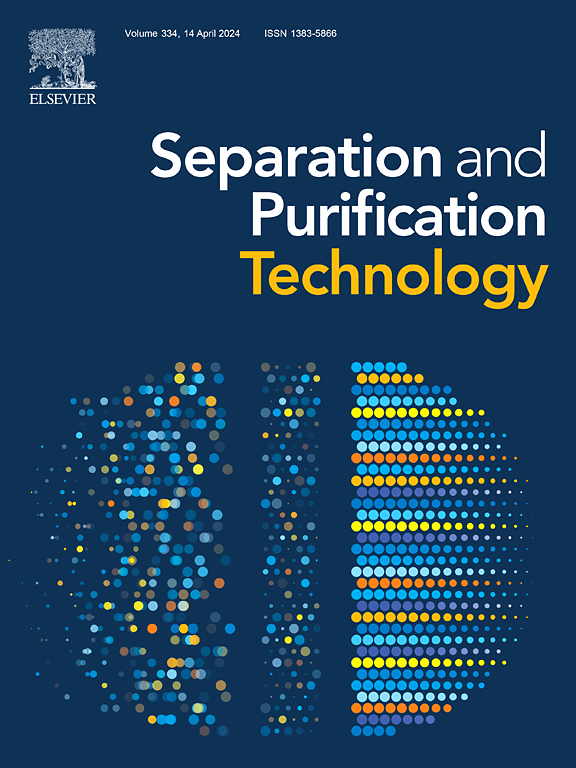聚酰胺增强海藻酸盐基水凝胶用于从海水中高效提取铀
IF 8.1
1区 工程技术
Q1 ENGINEERING, CHEMICAL
引用次数: 0
摘要
核电的可持续发展取决于能否获得充足、稳定的铀资源。虽然海洋含有丰富的铀,但其浓度低和各种干扰离子的存在给从海水中提取铀带来了很大的挑战。制备了具有高稳定性和高吸附能力的海藻酸钠-聚偕胺肟/超支化聚酰胺水凝胶球。通过海藻酸钠与Ca2+交联成型凝胶球,并通过戊二醛的共价交联形成三维网络结构,使水凝胶球具有很大的稳定性并形成孔隙结构。因此,独特的球形结构赋予了它无与伦比的回收性能,提高了其提取铀后高效回收的能力。吸附实验表明,在pH = 6的条件下,吸附量最大可达537.8 mg·g−1。值得注意的是,水凝胶球可以在更大的pH范围内吸附铀,并保持形态稳定性,这使得它们适合在海水等复杂情况下回收铀。在5次吸附-解吸循环中均保持了良好的吸附能力,去除率在95.07 % ~ 87.37 %之间。动态循环实验表明,在实际海水中铀的提取率仍可达82.59 %,具有较高的海水应用潜力。本文章由计算机程序翻译,如有差异,请以英文原文为准。


Polyamide reinforced alginate-based hydrogel for efficient uranium extraction from seawater
The sustainable development of nuclear power hinges on accessing sufficient and stable uranium resources. Although the ocean contains abundant uranium, its low concentration and the presence of various interfering ions pose great challenges to extracting uranium from seawater. Herein, the sodium alginate-polyamidoxime/hyperbranched polyamide hydrogel spheres with high stability and adsorption capacity were developed. The gel spheres are molded by crosslinking sodium alginate with Ca2+ and form a three-dimensional network structure through the covalent cross-linking of glutaraldehyde, which endows the hydrogel spheres with great stability and forms a pore structure. Accordingly, the unique spherical structure endows it with unparalleled recovery performance, enhancing its ability to efficiently recycle after uranium extraction. Adsorption experiments show that the maximum capacity reaches 537.8 mg·g−1 at a pH of 6. Notably, the hydrogel spheres can adsorb uranium over a larger pH range and maintain morphological stability, which makes them suitable for uranium recovery in complex situations like seawater. Furthermore, the adsorption capacity was successfully preserved in five adsorption–desorption cycles, with a high removal rate from 95.07 % to 87.37 %. The dynamic cycle experiment reveals that uranium extraction in real seawater can still reach 82.59 %, indicating a high potential for seawater applications.
求助全文
通过发布文献求助,成功后即可免费获取论文全文。
去求助
来源期刊

Separation and Purification Technology
工程技术-工程:化工
CiteScore
14.00
自引率
12.80%
发文量
2347
审稿时长
43 days
期刊介绍:
Separation and Purification Technology is a premier journal committed to sharing innovative methods for separation and purification in chemical and environmental engineering, encompassing both homogeneous solutions and heterogeneous mixtures. Our scope includes the separation and/or purification of liquids, vapors, and gases, as well as carbon capture and separation techniques. However, it's important to note that methods solely intended for analytical purposes are not within the scope of the journal. Additionally, disciplines such as soil science, polymer science, and metallurgy fall outside the purview of Separation and Purification Technology. Join us in advancing the field of separation and purification methods for sustainable solutions in chemical and environmental engineering.
 求助内容:
求助内容: 应助结果提醒方式:
应助结果提醒方式:


